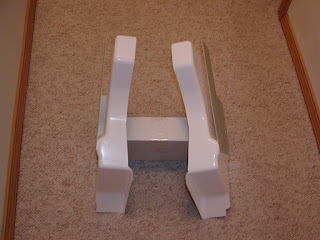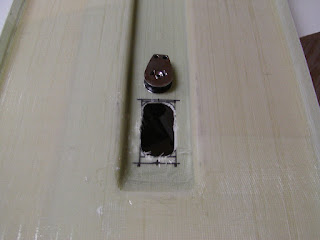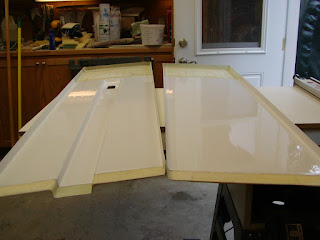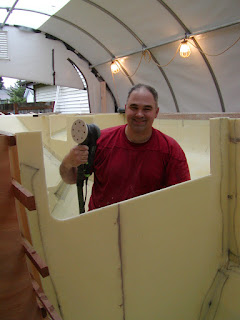 I then started working on getting the hull half popped loose. I don't remember exactly how long this took me, but it feels like it was at least an hour, maybe two. I had initially thought that I could run some lines from the peak pole of the tent, and use them to pull it out:
I then started working on getting the hull half popped loose. I don't remember exactly how long this took me, but it feels like it was at least an hour, maybe two. I had initially thought that I could run some lines from the peak pole of the tent, and use them to pull it out:
But this didn't work -- just couldn't get enough grip on the line I guess, and it was nylon so it was stretchy. (Probably if I had tied the line to a ratchet it would have worked.) I went back to the trial-and-error way, pushing and pulling here and here, looking for spots that were still stuck. The access hole by the transom makes a great pulling spot, and this was the area that popped loose first:
 Next I put my sawhorses in the back yard, layed 2'x4' pieces of wood across them:
Next I put my sawhorses in the back yard, layed 2'x4' pieces of wood across them: This is about the flattest part of my yard (except for where the boat tent is). I did my best to get everything level, using shims under the sawhorse legs; it's not perfect, but I think it will be good enough. Especially since I plan to get the starboard half done as quick as possible.
This is about the flattest part of my yard (except for where the boat tent is). I did my best to get everything level, using shims under the sawhorse legs; it's not perfect, but I think it will be good enough. Especially since I plan to get the starboard half done as quick as possible.Now I was ready to completely unmold the hull half, and lay it on the sawhorses. Fortunately all of the neighbors were around today and willing to help. Sean\Bill\Scott\Jim -- thanks a ton guys! I couldn't have done this without you! Unfortunately, no one was available to take pictures of the moving process. Too bad, there would have been some good shots.
We didn't have much of a strategy -- we just pulled the hull half straight up as far as we could get it, then turned it over almost inside the mold, with the deck rotating under. This was all done by hand - no lines or tackle or gantries. Once we had it turned over, we headed out the back of the tent. Here there were some minor difficulties -- scraping the top of the hull half against the tent door flap, then scraping against the oak tree that's right behind my tent -- but in less than five minutes it was all done.
Grant asked me about how stiff the hull was. I thought it was very stiff, and during the move I never saw any serious deflection of the hull shape. I had lots of help on hand and was glad I had them due to the constrained space I had to work in. I'm not sure two people would be enough unless you had lots of space to move around in, and overhead lines to hoist the hull half where possible.
Anyway, here she sits:

(Yeah, I need to throw some more support under the transom area.)
And:



I then spent some time doing cleanup work in the tent. This is partway through the cleanup, which is why stuff is sitting or hanging on the mold; you can get a feel from this picture how much clearance we had to work with between the top of the mold and the tent door flap (and the oak tree branch):
Last job for the day was taking down the form frames. I thought this job would last into tomorrow, but I was able to surprise myself:




























